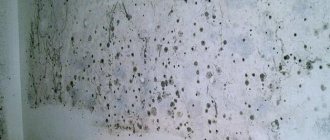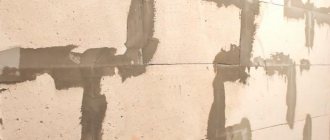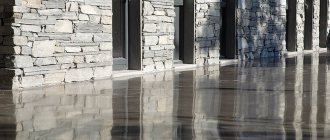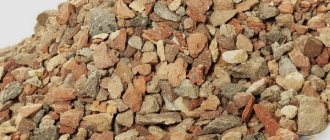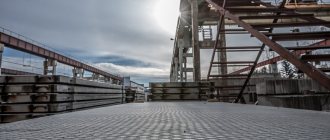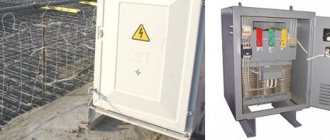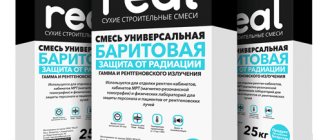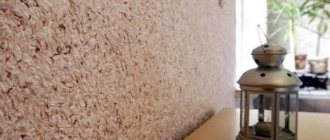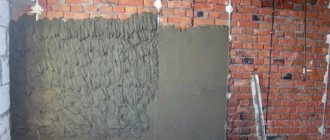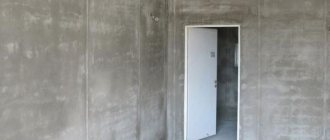In damp conditions, mold forms on concrete structures - dark spots of various shapes that spoil the cosmetic appearance of the walls. They can appear on both concrete walls and plaster. This fungus is not able to destroy concrete structures unless it has been on them for decades, but its spores spread to other interior items - furniture, household appliances, plastic structures, clothing and destroys these things. But the main danger of the fungus is that it enters the human body through the respiratory tract and gastrointestinal tract and causes diseases of the respiratory tract and other internal organs.
Therefore, after construction, concrete walls must be treated with special septic tanks that penetrate deep into the concrete structure and protect it from mold.
Definition and purpose
An antiseptic for concrete is a special impregnation that penetrates the pores of concrete and protects it from the influence of the external environment, in this case from the penetration of fungus into them.
The function of an antiseptic is to protect the surfaces of concrete products not only from the destructive effects of mold and moisture; the antiseptic also copes with the following tasks:
- protection of concrete from all microorganisms;
- reducing the impact on concrete of chemicals entering the product from the outside;
- protection from ultraviolet radiation and temperature changes;
- the antiseptic binds the molecular structure of concrete and strengthens it.
Signs of infection and their prediction
Mold does not appear on concrete immediately - in most cases, spores of parasitic microflora settle on the surface of structures outside, often indoors during operation. Risk groups include:
- Bathrooms and toilets;
- Kitchens without hoods, especially in hostels and catering establishments without proper treatment;
- Rooms whose walls go to the upper ceiling (roof) or to internal wall junctions, where precipitation drainage is poorly organized;
- Basements, often unheated;
- Old and dilapidated houses, where the microclimate is disturbed and high humidity prevails, walls are leaking, etc.
It is not always possible to notice the appearance of fungi right away - you never know where the outbreak forms. How he introduces himself:
- The appearance of colored spots on wet lesions;
- Wallpaper and paint are falling off, plaster is crumbling;
- After repair, the new cladding quickly comes off;
- A characteristic smell of rot appears.
The obvious smell of mold and black spots are the most dangerous signs of poisonous mushrooms for human health. Nevertheless, it is necessary to begin elimination immediately after detecting primary signs of infection. An antiseptic for concrete against mold will help with this.
Areas of application of antiseptics
Concrete surfaces in residential and non-residential premises are treated with an antiseptic, primarily those where high humidity is expected, and there are objects made of other materials that are more susceptible to destruction by fungus than others.
It is also used to treat brickwork, artificial stone coverings, foundations, concrete supports and the base of swimming pools.
Depending on the area of application, antiseptics are of the following types:
- Water soluble . They are used on surfaces that do not have reinforcement, since these septic tanks contain substances that destroy steel reinforcement, so the use of antifungal agents of this type is very narrow.
- Organic antiseptics . Used for impregnation of surfaces made of concrete, brick, ceramic tiles and artificial stone. They are very toxic, so personal protective equipment must be used when working with them. Protect the surface from fungus for several years.
- Combined antiseptics . The production technology is more complex than the previous ones, so they are more efficient. They consist of various solutions diluted with water in different proportions. They eliminate fungus and prevent spores from germinating into the microstructure of concrete.
Processing methods
It is necessary to work with drugs according to the instructions and follow the exposure time, proportions, and recommendations.
Preliminary protection
The best option is to treat the surface of concrete structures before the appearance of fungi immediately after installation or during the first and each subsequent finishing.
The solutions are brought to the required concentration (diluted if necessary) and applied to the surface with rollers, the corners are worked with a brush. It is important to saturate every centimeter of the base. The best effect is achieved when treated with 2 layers of antiseptic.
Combination
Some products are suitable for combination with primers or plasters or are already included in their composition. In this case, it turns out to combine surface antiseptic and finishing stages. It is necessary to strictly observe the proportions of preparing solutions.
Safety
Before starting work, it is necessary to reliably protect yourself with respirators and gloves; it is recommended to use a plastic raincoat or work uniform, which then must be thoroughly washed at high temperature. These measures will help maintain health (spores getting on mucous membranes and in the respiratory tract provokes poisoning and allergies), and cleaning clothes will prevent fungi from traveling to other rooms.
It is necessary to clean the surface as much as possible - remove build-up and loose concrete if it has already partially peeled off. Some products are applied directly to the colonies, read the instructions!
After preparation, an anti-fungal agent is applied to the surface and the time specified in the instructions is waited. Impregnation must be carried out several times, since many types of parasites are very tenacious. It is also important to apply the drug not only until the fungi completely disappear, but also on a healthy surface to prevent relapse.
Causes of fungus on concrete
To prevent further spread of the fungus and prevent its appearance in other rooms, you should know the causes of mold:
- An inefficient heating system leading to high humidity – a favorable environment for fungus.
- Insufficient air exchange or lack of ventilation, which additionally allows fungal spores to spread throughout the room.
- Insufficient thermal insulation of the building from the outside.
- Poor quality waterproofing of installation joints and building foundations.
- Laundry is drying in the room.
- The presence of indoor plants in large quantities.
Reasons for appearance
Mold can appear on a concrete wall when favorable conditions arise: if the room is poorly ventilated, has high humidity and low temperature, spores accidentally introduced into it are highly likely to begin to develop.
It is often observed in rooms where corners are poorly heated, in places with high groundwater levels, when the sewer system is malfunctioning, or when there is a malfunction in the roof drainage system. If mistakes were made during construction, the risk of fungal infections also increases.
Homemade remedies against fungus and mold
Sometimes folk remedies are used against fungus, one of them is vinegar and soda. Before treating infected surfaces, scrape off all the fungus with a spatula and wipe the walls with a rag soaked in vinegar or spray the product onto the walls with a spray bottle.
To obtain a soda solution, simply dilute a teaspoon of soda in a glass of water and apply a homemade antiseptic to the infected walls with a rag or spray. It is important to treat even hard-to-reach surfaces to ensure that fungal colonies are destroyed. If, after treating with soda and vinegar, mold appears again, it is necessary to use special means to combat the fungus.
Types of anti-mold, features and consumption
Modern anti-mold components of concrete are produced in a liquid, ready-to-use solution, and as part of dry mixtures for construction work. The active poisons in them are fungicides, and the base can be mineral, alkyd or acrylic. Based on their chemical composition and solvent, liquid antiseptics are:
- water soluble;
- organic;
- oily;
- combined.
All of them are capable of destroying colonies of harmful fungi and preventing their reproduction, but they have different properties.
Manufacturers of antiseptics
There are many types of septic tanks from different manufacturers on the market; Table 1 shows the most popular ones.
Table 1 – Rating of the best antiseptic manufacturers
| Name | Property | Price |
| Ceresit ST-99 | An effective product that penetrates deep into the pores of concrete and destroys mold. | From 300 rubles per 1 liter |
| Northex | Effective not only for concrete, but also for brick, toxic and flammable. Safe for metal fittings. Creates a protective film against mold. Refers to low-hazard substances according to GOST 12.1.007 | 4700 rubles for 21 kg |
| Gambit N-5 | A combined concentrate for treating already contaminated walls, to be diluted in water. | 900 rubles for 3 kg. |
| VGT bio | It has a powder structure and is diluted with water. Penetrates deeply into concrete. It has a destructive effect on metal; it is not recommended to use it on surfaces reinforced with metal reinforcement. | 900 rubles for 10 kg. |
Information sources:
- GOST 12.1.007 – harmful substances.
- GOST 32017-2012 – materials and systems for the protection and repair of concrete structures.
- GOST 31384-2008 – Protection of concrete and reinforced concrete structures from corrosion.
What is the danger
It is imperative to remove mold, as it poses a health hazard to people living in the affected premises. The spores are highly toxic.
They can enter the human body from the air during breathing, through pores on the skin. Penetration through the circulatory system through cuts is also possible.
Because of this, the following may develop:
- asthma;
- various allergic reactions;
- eating disorders;
- severe headaches (migraines);
- bronchopneumonia;
- rheumatic joint pain and other pathological processes.
Mold is especially dangerous for young children, the elderly, those suffering from allergic reactions, those with weakened immune systems, during illness, during the recovery period and during pregnancy.
Mold is dangerous even when it occurs in a room where people do not permanently live. Although the health impact is much lower in this case, the fungus can deteriorate the concrete, making it less durable. Because of this, collapses are possible.
Consumption
| Consumption not less than: | For 1 sq. m | Number of layers |
| Prevention of damage to healthy surfaces | 120 g. | 1-2 |
| Treatment of affected surfaces | 240 g | 2-3 |
The NORTEX-Doctor composition is a complex of biocidal additives that are resistant to leaching (substances designed to combat microorganisms that destroy the surface). Under the action of microbial enzymes, the biocide is released precisely in the place where protection is needed, thereby destroying microorganisms and preventing biodestruction.
Cleaning indoor walls
For work, solutions are used that have the necessary properties for specific operating conditions, materials, and the room itself. To protect a wall in a dry, unheated basement you will need one antiseptic, for a bathroom in an apartment - a completely different one. Typically, water-based anti-fungus and mold primers are used for interior work.
Stages of the procedure:
- Moisten the affected areas to prevent the spores from spreading further.
- Clean the floor, walls and ceiling with a spatula or sandpaper, or a metal brush, going well beyond the damage. Throw away all the finishing without trying to erase (from wallpaper, for example) microorganisms.
- Saturate the surface with a disinfectant, let it dry for the required time, and reapply a layer. In difficult cases, apply periodically up to 5 times.
- Perform a clean finish.
Let's deal with the problem
If mold has already appeared, you will have to take measures to eliminate it. You can do this yourself or call a special service (there are such services in Moscow, St. Petersburg and many other large cities).
Preliminary stage
It is important to dry the concrete before removing mold. If this preliminary step is not taken, other measures will not be very effective in controlling parasitic fungi. The affected area is then moistened with plenty of water to stop the spread of spores.
It is important to scrape off mold from the walls using a wire brush. The plaster will also have to be removed. Experts recommend cleaning the front layer of concrete as well. All removed parts of the trim must be removed from the premises.
Antiseptics
An effective way to get rid of mold fungi is to use antiseptic agents. When choosing what to treat the surface with, you should give preference to professional products from hardware stores. Traditional methods are often not effective enough.
The chemical is applied to the affected area. The radius of application must exceed the area of infection by at least 1 m. When the first layer has dried, it is necessary to re-treat the surface with the chemical. If necessary, you can repeat the procedure again.
It is important to correctly calculate the consumption of concrete antiseptic in order to immediately acquire the required amount. The last layer is applied with antibacterial impregnation.
The best antiseptics:
- "Dali." This domestically produced antiseptic is a professional product. To get the desired effect, you will have to apply the product 2-3 times in 2-3 weeks.
- "Neomid BIO", which is also produced in the Russian Federation, is intended for treating surfaces before applying paints and varnishes. The liquid is sold in plastic bottles.
- "Alpa Fongifluid". The solution must be applied before painting the wall or ceiling.
Security measures
Methods for dealing with fungal infections of walls are often unsafe for humans: many chemicals are toxic and can negatively affect health.
When working with chemicals, it is necessary to use protective gloves, goggles, and a respirator. Clothing must completely cover the body (including the head). The room must be ventilated during cleaning. After completing the treatment, you cannot enter the room without special clothing for 2 days.
For some products the period will be longer; You must read the instructions for use. If there was any food left in the room, you will have to throw it away.
Prevention against mold in the apartment
It is always easier to prevent a problem than to deal with its consequences. And even if mold treatment has been carried out, this does not guarantee that it will not return again. In this regard, it is recommended to follow a few simple rules:
- In rooms with high humidity, wash walls more often. When wet cleaning, wipe the surface dry.
- Treat surfaces with antifungal additives to prevent the development of fungus.
- Provide ventilation in the kitchen and bathroom. It is advisable to install electric ventilation in the bathroom.
- High-quality heating of a house or apartment in winter. It is in cold weather that the room is most susceptible to dampness - an ideal environment for fungal spores.
- Seal cracks in windows, seal cracks in walls - eliminate any source of moisture entering the house from the outside.
- If walls facing the street are affected by fungus, it is necessary to install thermal insulation.
Mold on the walls in an apartment is a dangerous phenomenon. It causes harm to health and can destroy even the highest quality building materials. In addition, fungi and spores entering the body can lead to serious illnesses. Solving this problem is not as difficult as it seems at first glance. You just need to prepare the wall and apply a special compound. Prevention is equally important. Mold will never appear in a well-heated house in which fresh air circulates, the walls are insulated and insulated from cracks, and the humidity level does not exceed acceptable standards.
What types of mold exist, and what harm do they cause to human health?
There is a huge variety of molds. Each of them poses a danger to human health. By constantly staying in a house infected with fungus, you can acquire chronic diseases.
The most common types of mold that often “settle” in a residential building:
Black. Most often this is the type that appears on the walls. Can appear on any type of surface. Concrete, plaster, wallpaper, paint, and wood are equally easily affected.
Wall affected by black rot
Why it is dangerous: with constant exposure to the human body, it can cause dizziness, sleep disturbance, and insomnia. Headaches are common, and body temperature may rise. The worst option is dermatitis or the development of diseases of the respiratory system: bronchitis, asthma, pneumonia and even lung cancer.
White. It appears in the apartment mainly in flower pots. Appears on walls in rare cases. Excessive watering or the application of certain fertilizers can provoke the development of fungus.
Wall affected by white rot
Why it’s dangerous: less harmful option than the previous one. But if you do not fight this “pest,” it can provoke the development of allergic reactions in humans.
Blue mold. Settling in wood fiber, it affects wooden surfaces: frames, parquet, wooden furniture. Under their influence, the tree acquires an unattractive bluish-gray tint.
Tree affected by blue rot
Why it is dangerous: the fungus destroys the paintwork and forms microscopic channels in the wood. Water gets into them, increasing the moisture content of the wood. This creates more favorable conditions for mold to grow.
Green. Most often it develops on food products. It can often be seen on bread. Occasionally it develops on building materials, for example, on brick.
Wall affected by green rot
Why it is dangerous: fungal spores, once in the human body, are digested by the gastrointestinal tract and excreted from the body. If the immune system is weak, the spores enter the bloodstream and cause serious illness. Among them: liver cirrhosis, bronchial asthma, benign and malignant formations.
Mold rotting. Like blue rot, it affects wooden surfaces. A characteristic sign that rotting mold is developing in wood is a gray or brown tint to the top layer of wood products.
Wood rotting
Why it is dangerous: after exposure to this fungus, the wood becomes lighter and becomes covered with cracks. In the most advanced cases, a complete replacement of wooden surfaces is required: frames, floor boards, parquet, furniture.
